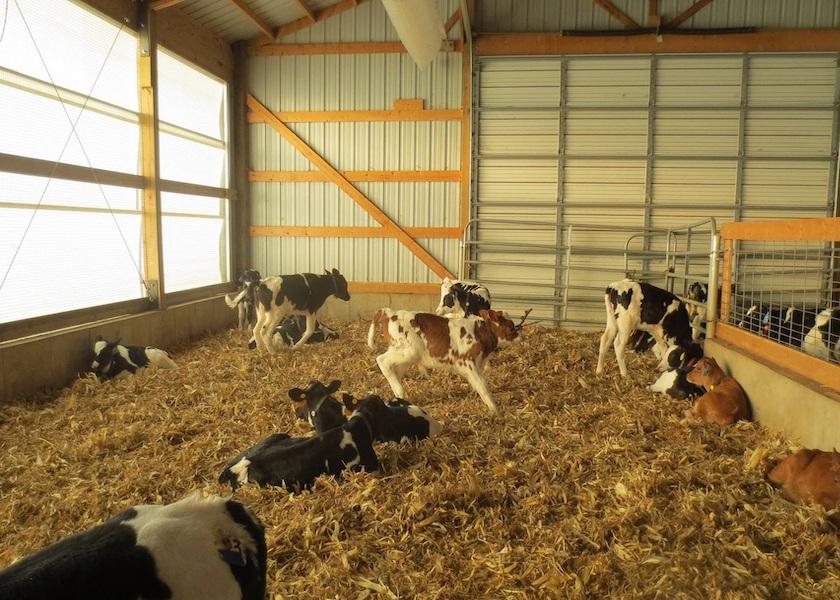Probiotics Improve Early Weight Gain in an Automated Milk Feeder Study

In the quest to determine the best methods of providing enhanced nutrition and supplemental support to preweaned dairy calves, a team of North American researchers conducted a trial to explore when the optimal timing is to provide high milk allowances to dairy calves, and if probiotics could improve calf growth.
University of Wisconsin-Madison researcher Melissa Cantor (soon to be an Assistant Professor of Precision Dairy at Penn State University) was the primary investigator for the study, the results of which were published in the Journal of Animal Science. Cantor collaborated with researchers from UW-Madison, the University of Kentucky, and Canada-based Next Generation Dairy Consulting.
In addition to evaluating two delivery schedules for high-milk-volume diets, the team wanted to assess whether the addition of a daily probiotic had any influence on calf performance, behavior, or health.
“Probiotics can stabilize microflora populations within the small intestine, outcompete deleterious pathogens, and enhance intestinal barrier functions,” Cantor explained.
They said this phenomenon, called “competitive exclusion,” has been shown in previous research on calves fed limited milk allowances to promote milk intake, help calves cope with environmental stress, and improve average daily gain (ADG).
In the current study, the team wanted to see if the addition of a probiotic treatment would affect performance and feeding behaviors in calves fed higher milk allowances. A total of 96 Holstein heifer calves at a commercial dairy in Wisconsin were enrolled.
The two feeding protocols both allowed abundant access to unsalable pasteurized whole milk, delivered via autofeeders. Introduction to the autofeeders started at about 1 week of age for all calves. Both feeding programs offered a total of 543 liters of milk over the course of the milk-feeding period, but at different allowance rates.
Protocol 1 offered a maximum of 11 L/day on day 1 at the autofeeder, with a peak milk allowance of 15 L/day on day 21. Protocol 2 peaked later, starting with a maximum allowance of 7 L/day on day 1, up to 13 L/day on day 28. In both protocols, milk allowances were reduced gradually after peak, until weaning at day 53. Calves were also offered free choice access to grain from a feed bunk.
The probiotic product used was a gel formulation of lactic acid combined with the live yeast Saccharomyces cerevisiae. It was delivered once to each calf at colostrum feeding. After calves were enrolled on the automated feeder, the autofeeder mixed the probiotic powder into the milk twice daily throughout the milk-feeding period. Half of the calves under both nutrition protocols received the probiotic, with the other half receiving a placebo.
While the addition of the probiotic ultimately did not affect total average daily gain by week 1 after weaning, it did prove to have significant impact in earlier phases of the study. Probiotic-fed calves:
- Had higher ADG and body weights in the first 28 days enrolled on the automated feeder (probiotic 1.8 ± 0.2 lbs./day vs. placebo 1.6 ± 0.2 lbs./day), while milk consumption was not different.
- Visited the bunk to consume starter grain more frequently during and after weaning (probiotic 37.8 ± 2.8 visits vs. placebo 23.2 ± 2.8 visits).
- Did not have different total time at the feed bunk during and after weaning compared to the placebo calves (53 min per day for both).
- Probiotic calves spent more time lying down (over an hour more per day) compared to the protocol 1 placebo calves.
The researchers suggested that the improvements in gain likely were due to competitive exclusion. They said both lactic acid probiotics and those containing S. cerevisiae yeast have been shown to produce increased growth in calves without influencing milk or feed intake.
In this study, milk and feed intake were not different between the probiotic and placebo groups, but the probiotic calves had better early weight gains, indicating that they utilized nutrients more efficiently. For the milk protocols, protocol 1 calves had similar growth to the protocol 2 calves across the study, but the protocol 2 calves consumed nearly 100 L more milk across the study. Cantor suggested that this research indicated the importance of offering near-free-choice levels of milk to the calves as soon as they were enrolled on the automated feeder.
Additionally, the researchers noted that the study herd had high disease pressure, as 92% of the calves in the study had at least one case of pneumonia, and 82% had diarrhea. Previous research on S. cerevisiae has shown that the yeast supplement is most beneficial to calves under intense disease pressure. The researchers suggested that probiotics may be beneficial to calves offered high milk allotments from an automated milk feeder when under high disease pressure.







